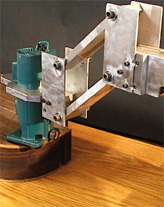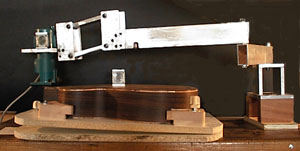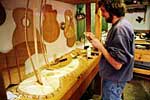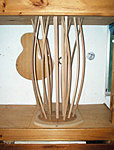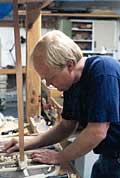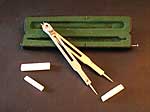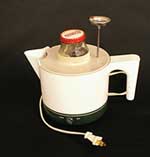
|
Home | Courses of Study |
Build Better Router Jigs |
|
Mail your check to: |
And Another Router Fixture |
|
Here is another router fixture for you. I came across it
in the Fall 2002 (No. 71) issue of American Lutherie. What caught my
eye was a picture of Harry Fleischman, blindfolded, routing the binding
ledges of a guitar body.
“That’s for me,” I said as I looked at
the article with yet a stronger pair of reading glasses.
This device is somewhat more complex than the Nickerson fixture
described above. It requires a carriage for the guitar to keep the surface
being routed level for one thing, and because the router moves over
a stationary guitar body, the horizontal depth is controlled by a concentric
bearing attached to the cutter itself rather than the adjustable horizontal
depth adjustment on the Nickerson jig. This means you have to get cutters with bearings
to make standard cuts for bindings and perflings. I use a 1-inch cutter
with bearings to cut for my standard bindings and perflings. I use ½-inch
bearings with sleaves machined and press fit to the bearings to make
the required cuts. The vertical adjustment is made using the router’s
adjustable base. I just change the bearing to adjust the horizontal
depth of cut.
The advantage of this device is that one moves the tool rather
than the work. While moving the body around to make ledge cuts with
the Nickerson device works well, it does require a fair amount of practice
to get it right. The Fleischman device has an omnidirectional cutting
plane, therefore one only needs to run the router around the body and
voila! The job is done.
I built my fixture out of T-2 aircraft aluminum. In the article
in American Lutherie, Harry describes one made of wood. Either will
do. Be sure to use thrust bearings at all pivoting points both on the
arms controling horizontal movement and the pivots controling vertical
movement. These bearings are best obtained from either Granger Industrial
Suppliers or MSC Industrial supply. Get oil empregnated bronze bearings.
I have two small levels which I use to set up the router and the guitar body. Using them assures that the cutter is making a perpendicular cut. |
|
|
|
|
|
|
|
Download an MS Excel spread sheet for guitar calculations |
|
All The
Critical Calculations For Building a Guitar: If you'd like a copy of the spread sheet email us and we'll send it to you. |
|
|
|
|
When Violinists Play, Their Violins ImproveResearcher in England say that laboratory tests conducted on wood commonly used to make violins support age-old claims by musicians that the regular playing of a stringed instrument improves its tone. By Warren E. Leary (Excerpted from the New York Times) Dr. David G. Hunt of the School of Engineering Systems and Design at South Bank University in London sways his studies with pieces of spruce show that continuous forced vibrations similar to those experienced with regular use of a musical instrument changes the nature of the wood. In a letter published in the current issue of the journal Nature, Dr. Hunt and a graduate student, Emmanuel Balsan, said that wood vibrated in condition of high humidity increased in stiffness and saw a decrease in dampening coefficient, a measure of cycles of vibrations emanating from the material. Both factors are know to help provide more pleasant tones in spruce, mature pine and other woods used in instrument sounding boards, experts say. Dr. Hunt, who studies the structure of wood for the construction industry, said the results concerning musical instruments were a byproduct of research in the effect of moisture in wood. A music lover and avid concertgoer, he said he built a guitar several years ago but was not a violin expert. "People don't understand entirely the structure of wood, even after using it and studying it for centuries," he said in a telephone interview, "Part of the strength of wood is based on the amount of water in it and the way it bonds." The researchers vibrated beams of spruce at 10 cycles per second for 48 hours and the damping coefficient went down by 5 percent. The changes persisted when the vibrations stopped, they said. Lower damping coefficients mean that a single note is heard longer, which is considered a beneficial attribute. When the wood was vibrated in a chamber where the humidity was taken up to 80 to 90 percent, the damping coefficient went up fast before drifting downward, they reported. This resulted in a decrease in damping and increase in stiffness during vibrations that persisted when the vibrations were turned off, they said. Dr. Hunt attributed the changes in the wood to a redistribution of moisture in the wood caused by the vibration that remained stable for several days after the test. Over time perhaps months, he speculated, the wood was expected to go back to its initial state of equilibrium unless the vibrations were applied periodically. "Musicians have said that the sound of an instrument gets better the more you play it, and we have found a basis for that," he said. "Although for the best care of a musical instrument, both high and low humidities should be avoided," the researchers wrote, "the results suggest that at intermediate or high humidities, the sound quality may be improved by regular playing." Carleen Maley Hutchins of
Montclair, NJ, considered one of the world's best violin makers and
researchers, said she found the British work interesting and consistent with
much of her research. Among other things, she has vibrated violins for 1,600
hours using frequencies from radio broadcasts and found that this changes
wood resonance. "This
would appear to complement work I have been doing," Mrs. Hutchins said
in a telephone interview, "but I would question their conclusion that
moisture bonding is the reason. There is research to indicate that the
molecular bonds of wood actually break because of vibration and that this
what affects the tonal qualities. So I think there may be more to it than
moisture bonding." |
Leeds Guitarmakers Click here to send an inquiry or comments to Leeds Guitarbuilders' School 12 North Main Street - PO Box 434 - Williamsburg, MA 01096 (413) 582-0034 |
Home | Courses of Study Tutorials | Guitarmaking Tips | Web Sites |
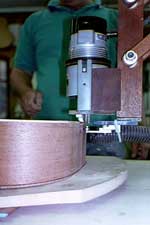
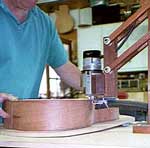
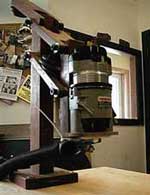 we can send them to you for $30 plus $1 for postage and handling.
we can send them to you for $30 plus $1 for postage and handling.
